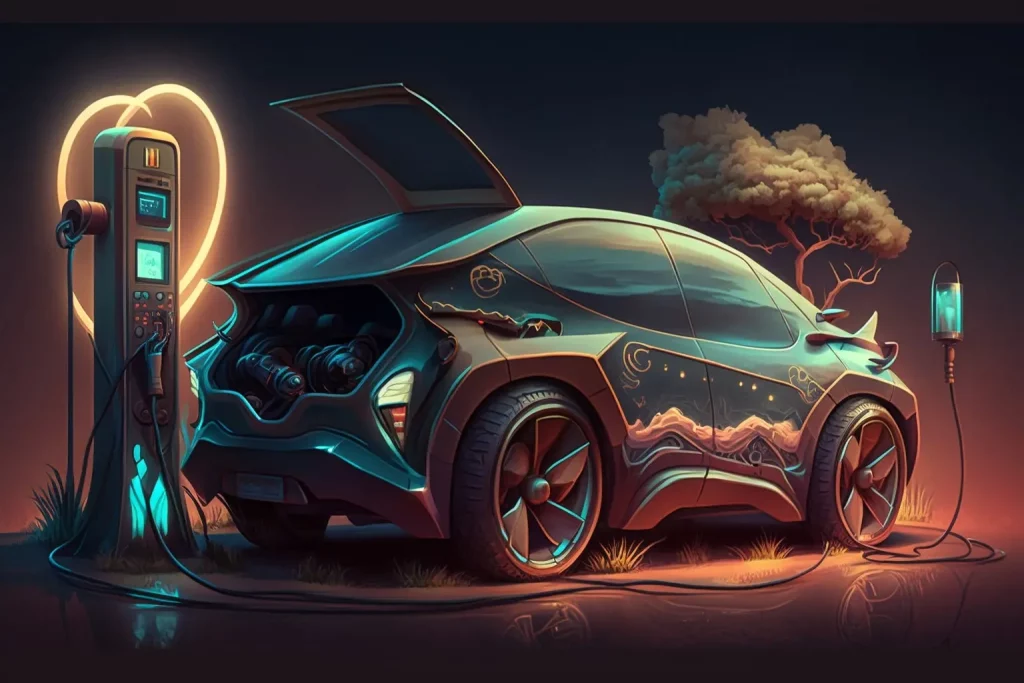As the world becomes increasingly concerned about climate change and environmental sustainability. The automotive industry is shifting its focus more and more toward electric vehicles (EVs) as the future of transportation.
The year 2023 is expected to be a pivotal year for the EV market, with major advancements in technology, infrastructure, and consumer adoption. In this article, we will take a closer look at the future of EVs in 2023, including the latest trends, challenges, and opportunities.
Overview of the EV Market
The global electric vehicle market has been growing at an exponential rate in recent years. Driven by factors such as government incentives, stricter emission regulations, and consumer demand for eco-friendly transportation options.
According to a report by BloombergNEF, global EV sales are expected to reach 54 million by 2040, accounting for over 30% of all passenger cars sold. The market is also expected to see a significant boost in the next few years, with experts predicting that EVs will reach cost parity with gasoline vehicles by 2025.
Latest Trends in EV Technology
One of the major drivers of the EV market is the rapid advancements in technology. EV batteries have been a key focus for researchers and manufacturers, with the goal of achieving long-range, faster charging and lower costs.
In 2023, we can expect to see significant improvements in battery technology, including the use of solid-state batteries, which offer higher energy density, faster charging times, and improved safety.
Automakers such as Toyota, Volkswagen, and BMW are already investing heavily in solid-state batteries and are expected to launch vehicles with this technology in the coming years.
Another major trend in EV technology is the development of autonomous driving systems. Self-driving EVs are expected to be a game-changer for the industry, offering improved safety, convenience, and efficiency.
Major players such as Tesla, Google, and Uber are already testing autonomous EVs on public roads and are expected to launch commercial services in the near future.
However, there are still significant challenges to overcome, including regulatory hurdles, cybersecurity risks, and consumer trust.
EV Infrastructure and Charging Networks
One of the biggest challenges facing the EV market is the lack of charging infrastructure. In order to encourage consumer adoption, it is essential to have a reliable and accessible charging network.
Governments and private companies are investing heavily in building out EV charging stations, with a particular focus on fast charging. In 2023, we can expect to see significant improvements in charging infrastructure, with the installation of ultra-fast charging stations and the expansion of charging networks in urban and rural areas.
Another trend in EV infrastructure is the use of renewable energy sources. Many EV charging stations are now being powered by solar panels, wind turbines, or other forms of renewable energy, which helps to reduce carbon emissions and promote sustainability.
Companies such as Tesla and Volkswagen are also exploring the use of stationary energy storage systems, which allow EV owners to store excess energy generated by their vehicles and use it to power their homes or businesses.
Consumer Adoption of EVs
While the EV market has been growing rapidly, there are still significant barriers to consumer adoption. One of the main challenges is the upfront cost of EVs, which is often higher than gasoline vehicles.
However, as battery technology improves and production scales up, the cost of EVs is expected to decrease significantly. In addition, many governments are offering incentives such as tax credits, rebates, and free parking to encourage consumers to switch to EVs.
Another barrier to adoption is the lack of consumer awareness and education about EVs. Many consumers are still skeptical about the performance, reliability, and practicality of EVs, and are not familiar with the different types of EVs and charging options.
Automakers and governments are taking steps to address this issue, by launching public education campaigns and increasing consumer access to test drives and information.
Opportunities and Challenges for the EV Market
While the EV market is poised for significant growth in the coming years, there are still many challenges to overcome. One of the biggest challenges is the need for significant investment in infrastructure, including charging stations, grid capacity, and renewable energy sources.
Governments and private companies must work together to make this happen, through funding and incentives.
Another challenge is the need for regulatory frameworks that can keep up with the rapid pace of technological innovation. Governments must strike a balance between promoting innovation and ensuring safety, security, and privacy for consumers.
Despite these challenges, there are also significant opportunities for the EV market. The shift towards electric vehicles presents a unique opportunity to reduce carbon emissions, improve air quality, and promote sustainable transportation.
It also presents opportunities for job creation and economic growth, particularly in the renewable energy and electric vehicle industries.
Comparing Electric and Fuel Vehicles
Now, let’s take a closer look at how electric vehicles compare to fuel vehicles. There are pros and cons to both, so let’s break them down:
Pros of Fuel Vehicles:
- Widespread availability: Gas stations are everywhere, making it easy to refuel your car on the go.
- Long driving range: Fuel vehicles typically have a longer driving range than electric vehicles, so you don’t have to worry about running out of gas as often.
Cons of Fuel Vehicles:
- High emissions: Fuel vehicles produce a significant amount of emissions, which is bad for the environment.
- High operating costs: Gasoline is expensive, and fuel vehicles require more maintenance than electric cars.
Pros of Electric Vehicles:
- Zero emissions: As mentioned earlier, electric cars produce zero emissions, which is better for the environment.
- Lower operating costs: Electric cars are much cheaper to operate than fuel vehicles, which can save you money in the long run.
Cons of Electric Vehicles:
- Limited driving range: Electric vehicles have a limited driving range, which means you’ll need to plan your trips accordingly and be mindful of where charging stations are located.
- Longer charging times: Charging an electric car takes longer than refueling a fuel vehicle, which can be inconvenient if you’re in a hurry.
Maintenance Costs Comparison Between EVs and Fuel Vehicles
One of the significant advantages of electric vehicles is their lower maintenance costs. Electric vehicles have fewer moving parts than traditional fuel vehicles, which means they require less maintenance overall.
For example, EVs don’t require oil changes, spark plug replacements, or timing belt changes. This can result in significant savings over the lifetime of the vehicle.
According to a study by Consumer Reports, electric vehicles can cost 50% less to maintain than gasoline vehicles over five years. The study found that EVs had an average maintenance cost of $0.03 per mile, compared to $0.05 per mile for gasoline vehicles.
Another advantage of electric vehicles is their regenerative braking system, which helps to extend the life of the brake pads and rotors.
When an EV driver applies the brakes, the regenerative braking system converts the kinetic energy into electrical energy, which is stored in the battery.
This means that the brakes don’t have to work as hard, which can reduce wear and tear on the brake pads and rotors.
In contrast, traditional fuel vehicles require more frequent maintenance, such as oil changes, air filter replacements, and spark plug replacements. These maintenance tasks can add up over time, resulting in higher costs for the vehicle owner.
Overall, the lower maintenance costs of electric vehicles can make them a more affordable and cost-effective option for consumers, particularly when combined with savings on fuel costs.
Conclusion
In conclusion, the future of electric vehicles in 2023 is bright, with significant advancements in technology, infrastructure, and consumer adoption. The EV market is expected to continue its rapid growth, driven by factors such as government incentives, stricter emission regulations, and consumer demand for sustainable transportation.
However, there are still many challenges to overcome, including the need for significant investment in infrastructure and regulatory frameworks that can keep up with technological innovation.
FAQs
What is an electric vehicle?
An electric vehicle (EV) is a vehicle that runs on electricity, rather than gasoline or diesel fuel. It is powered by an electric motor and a rechargeable battery, which can be charged from a wall outlet or a specialized charging station.
What are the benefits of driving an electric vehicle?
Electric vehicles offer a number of benefits, including lower operating costs, reduced emissions, and improved performance. They also offer a smoother, quieter ride, and require less maintenance than gasoline vehicles.
How long does it take to charge an electric vehicle?
The time it takes to charge an electric vehicle depends on the type of charger and the size of the battery. A standard Level 2 charger can take anywhere from 4 to 8 hours to fully charge a battery, while a fast charger can provide up to 80% charge in as little as 30 minutes.
Are electric vehicles more expensive than gasoline vehicles?
Electric vehicles can be more expensive upfront than gasoline vehicles, but they offer significant savings over time in terms of fuel and maintenance costs. Additionally, many governments offer incentives and tax credits to encourage consumers to switch to EVs.
What is the future of electric vehicles?
The future of electric vehicles is bright, with significant advancements in technology, infrastructure, and consumer adoption. Experts predict that EVs will reach cost parity with gasoline vehicles by 2025 and that global EV sales will reach 54 million by 2040.
References:
BloombergNEF. (n.d.). BloombergNEF. https://about.bnef.com/





